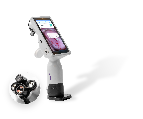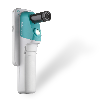Presented at the 2019 ASCCP Annual Scientific Sessions
Presented at the ASCCP 2019 Annual Scientific Meeting on Anogenital & HPV Related Diseases
Authors: JY Kim (1), SR Kim (2), SW Song (3), SY Kwon (4), J Kim (5), Ronen Nissim (6), Jonah Mink (6), David Levitz (6)
(1) Y-Queen Woman Clinic, (2) Dr. Kim ob/gyn clinic, Seoul, Korea, (3) Roen ob/gyn clinic, Seoul, Korea, (4) Riz ob/gyn clinic, Seoul, Korea, (5) Jiin ob/gyn clinic , Seoul, Korea , (6) MobileODT, Tel Aviv, Israel
Objective: Demonstrate effectiveness of the first use of a prospective, real-time machine learning (ML) algorithm in a clinical setting.
Methods: An ML classifier was developed from an existing image set from 1473 colposcopy patients (80% training, 20% validation). Annotations by two colposcopy experts were used as ground truth. The classifier was then integrated into a web service feature called from an image portal storing patient images and test results. The feature evaluates all images from the selected procedure, and provides both an automated impression and targeted feedback. This feature was piloted in a network of seven clinics in Korea, where combined cervicography and cytology are the screening standard of care. The results of the classifier were used to counsel patients on risk in order to improve loss to follow-up for high risk cases.
Results: The ML classifier developed had an area under the (ROC) curve (AUC) of 0.93. The Korea pilot is the first ML algorithm on cervical images tested in a clinical setting. To date, 343 patients were enrolled, with provider utilization at 100%. Data from N=209 patients are included in this study, and laboratory results from N=134 patients are still pending.
Conclusion: Preliminary results show widespread acceptance of AI at the point of care, and highlight potential to improve care and reduce costs related to cervical cancer screening.







